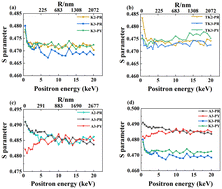Study on the defects of KDP crystal with different states by the positron spectroscopy method
Abstract
KDP and ADP crystals doped with different concentrations of Fe3+ ions were grown by the “point seed” technique and some KDP crystal samples were annealed. Positron annihilation lifetime spectroscopy and slow positron beam technique were applied to investigate the types and distributions of the defects with different states of charges for KDP and ADP crystals. It was found that the quality of the prismatic sector was better than that of the pyramidal sector, although Fe3+ was mainly enriched in the prismatic sector. The types and content of defects in the pyramidal sector were relatively larger. ADP crystals showed better structural stability, with fewer defects than KDP crystals. This might be one of the reasons for the higher damage threshold of ADP crystals. The results also indicated that thermal annealing could decompose large-size defects into small-size ones to improve KDP crystal quality. However, it could not reduce the influence of Fe3+, such as causing light absorption at 220–300 nm. In addition, the Raman spectroscopy, Fourier-transformed infrared spectroscopy, and ultraviolet absorption spectroscopy were implemented to illustrate the change in the structure and properties after doping in KDP crystals. Notably, this work focused on the types and distributions of microscopic defects, which would be significant for the crystal growth and quality improvement.



 Please wait while we load your content...
Please wait while we load your content...